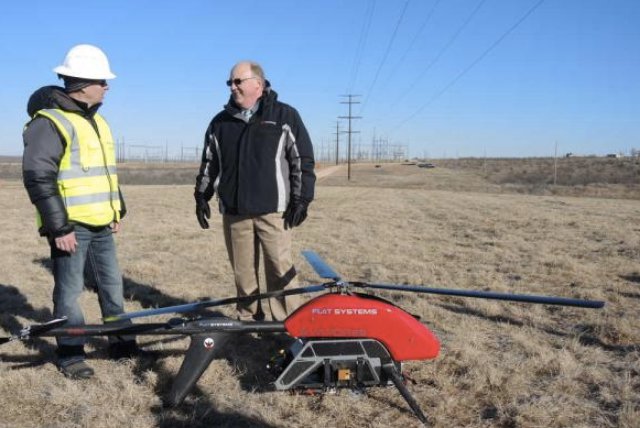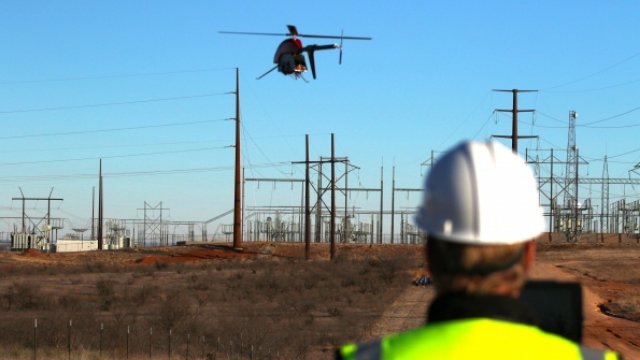has become the first utility company to use drones in beyond-line-of-sight inspections of more than 320,000 miles of electricity and natural gas infrastructure.
In partnership with Flot Systems, Xcel has launched the program following the Federal Aviation Administration’s regulations of unmanned aerial vehicles in January.
“We are the first to do this as a utility company, the first one for this type of mission,” Xcel spokesman Wes Reeves said Wednesday. “We’ve been watching the regulations for a long time to allow people to get these licenses from the FAA. Typically, we have used helicopters or ground patrols, but hopefully this will be less expensive and safer.”
Xcel began using unmanned aircraft to visually inspect substations in 2015, and is the first utility to receive and use the FAA’s certificate of authorization to perform a mission for research and development purposes beyond a visual line of sight.

Chris Vallier, left, CEO of Flot Systems, shows the Vapor 55 drone to David Hudson, president and CEO of Southwestern Public Service, an Xcel subsidiary.
“Today, we took a milestone step forward,” said Chris Vallier, CEO of Flot Systems. “This will provide better data streams than helicopters, and the intent over time is multiple flights a week.”
Xcel Energy inspects 320,000 miles of electricity and natural gas infrastructure, including more than 1,000 substations, gas regulator stations and dozens of major power plants in eight states.
Today, the company is using contractors, Environmental Consultants Inc. & FLōT Systems, to fly an unmanned inspection using a system that allows the aircraft to fly beyond the line of sight of the operator, a first for U.S. electric utility companies.
KFDA – NewsChannel 10 / Amarillo News, Weather, Sports
Xcel Energy has more than 7,000 miles of high-voltage transmission lines in its Texas-New Mexico service area alone. This first beyond-line-of-sight unmanned aircraft mission will be flown in an area known as the Canadian River Breaks north of Amarillo in the Texas Panhandle.
Previously, Xcel contracted helicopters that would carry an Xcel inspector and would fly along the transmission lines as the inspector typed data into a laptop.
“This takes high-resolution imagery of the lines, and you can view it as you take it,” said Brian Long, manager of transmission line performance for Xcel. “You can put lidar (light radar) or infrared sensors on it. We’re looking at things that could cause outages before they occur.”
Long said that from a safety viewpoint, flying unmanned aircraft near high-voltage lines is less of a risk for workers and pilots. Transmission line inspectors also used to walk through “areas of rough terrain that are more dangerous.”
In 2012, a McLean man was killed and another man was hospitalized after laying a roller on a power line.
Long said using drones will help minimize the risk to employees.
“Xcel Energy is committed to embracing new technologies that allow us to work safer, more efficiently and at lower costs than before, and the unmanned aircraft systems are a great example of boosting our productivity through technology,” said Teresa Mogensen, Xcel Energy’s senior vice president for transmission. “Employees will also use drones to observe environmentally sensitive areas without the use of trucks, helicopters or other utility equipment, minimizing the environmental impact,” she added.
Xcel has started using a helicopter-type drone called the Vapor 55, which has a range of 35 miles out of the pilot’s line of sight.
Its battery life can keep it in the air for up to one hour, and it can fly at speeds of up to 35 mph.
Soon, they will begin testing a fixed-wing unmanned aircraft, similar to a small plane, that has a 10- to 11-foot wingspan and a cruise speed of 100 knots, which is about 115 mph.
Flot officials said they were unable to disclose the model of the drone due to the company’s partnership with a Department of Defense contractor.
Source: Amarillo Globe News


What I am wondering is how a commercial operator legally flew beyond line of sight when your exemption specifically forbids that type of operation? I would love to hear all about how you convinced the FAA to allow such a feat.